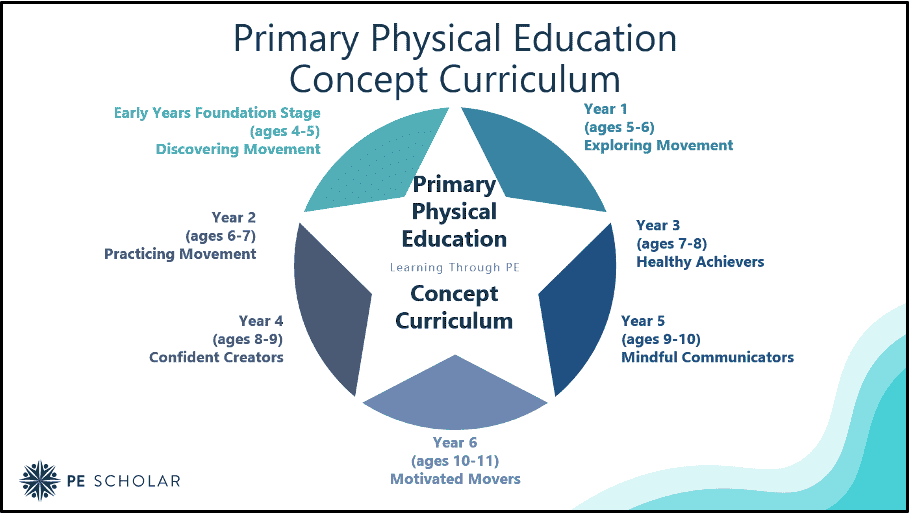
Introduction
Primary physical education (PE) holds a significant place in a child’s holistic development. It’s not just about the physical domain but can also develop character building, teamwork, and creativity. In this blog, we will guide you through a striking and fielding lesson designed for Year 6 students, focusing on the Primary Concept Curriculum. The primary aim of this lesson is to instil a positive work ethic in PE, provide opportunities for students to create and officiate their own striking and fielding games, and draw on their prior learning.
Signpost to Key Resources
In the video I signpost teachers to lesson observation resources that we hope can guide and support those embedding the Primary Concept Curriculum. The lesson observation prompts within the resource have been designed to provide non-judgemental and supportive prompts for observers to consider what an effective concept-driven lesson might include, how to build an inclusive and safe learning environment and considerations for holistic development.


The feedback sheet enables teachers and observers to reflect on various aspects of a PE lesson to support development and consider strengths.
Student Voice
In the video, I also touch on the importance of collecting student voice. We must seek out and accept the feedback from our students if we are truly to meet their needs and build a positive connection with PE, physical activity and sport. Leaders can use student voice as a tool for change and to ensure that our purpose meets our practice. Once we have received the student voice feedback there are a number of areas that we can use it to inform our delivery. The table below provides some examples of where we might look to use student voice to inform change.

Opportunities to Develop Physical Competence in the Lesson
- Skill Development: The lesson involves students in activities that require striking (hitting a ball or object with a bat) and fielding (defending and retrieving the ball). These activities help students acquire and improve motor skills related to striking, such as hand-eye coordination, timing, and precision.
- Balance and Coordination: Striking and fielding activities require balance and coordination. Students need to maintain balance while running, adjust their position to strike or field the ball effectively, and coordinate their body movements for accurate striking and fielding.
- Hand-Eye Coordination: Striking activities, in particular, enhance hand-eye coordination as students track the path of the ball and use their bats to strike it accurately. This skill is not only valuable in PE but also in various other activities and sports.
- Game Strategy: The lesson encourages students to develop strategies for their striking and fielding games. This involves planning, decision-making, and execution, all of which contribute to their cognitive and physical development.
Lesson Overview
- Lesson Introduction and Energise, Explore: Commence by arranging students into small groups and supplying them with various striking and fielding equipment, such as bats, balls, and cones. In their groups, students should brainstorm and craft their own striking and fielding game station. They should concentrate on strategies they’ve learned in previous lessons and ponder over what aspects of their game they wish to develop further.
- Link: Facilitate a discussion about work ethic. Pose questions like, “How confident did you feel when officiating today?” and “How did your motivation impact your effort in the game?” Encourage students to contemplate their contributions and their influence on the game.
- Activity: Provide students with planning and officiating worksheets. These worksheets should guide them in refining their games and officiating guidelines. Encourage them to contemplate how scoring works, how players get out, and how to ensure everyone gets a fair chance to participate. Students then have the opportunity to play the games they’ve created, as well as games created by other groups. This hands-on experience allows them to see the results of their planning and officiating.
- Discovery: After playing the games, students reflect on their work ethic, considering how it contributed to the game’s success and how it might impact other areas of their school life.
You may want to consider a follow-up lesson, students can share their games with others, allowing for more opportunities to officiate and play different games. They can also make adjustments based on feedback.
Conclusion
This striking and fielding lesson not only embeds essential physical skills, provides opportunities to practice, but also underscores the cultivation of a positive work ethic and encourages student autonomy and creativity. By empowering students to take ownership of their learning, you enable them to become active participants in their PE experience. As a primary teacher, you play a pivotal role in facilitating this process and guiding students toward a deeper understanding of the concepts introduced in this lesson.
Further Support
If you require further support or have questions, don’t hesitate to reach out via email or on Twitter. We hope this walkthrough helps you deliver engaging and meaningful PE lessons that leave a lasting impact on your students.
To find out more about the Primary PE Concept Curriculum, click here

Further curriculum ideas and resources
At PE Scholar we aim to provide high-quality materials and expert knowledge to make your teaching that bit easier. Below are some further resources and insights to support you with your PE curriculum.
Further lesson walkthroughs: Early Years, Year One, Year Two, Year Three, Year Four and Year Five
The Primary Concept Curriculum insight
PE curriculum design guest blog
Concept curriculum lesson templates
Concept curriculum non-performer worksheet
Mapping your PE Curriculum resource
Conceptual PE: a course for the future research publication
Purchase the Concept Curriculum – Primary and Secondary


[…] More Lesson walkthroughs: Year One, Year Two, Year Three, Year Four, Year Five and Year Six […]
[…] More Lesson walkthroughs: Early Years, Year Two, Year Three, Year Four, Year Five and Year Six […]
[…] More Lesson walkthroughs: Early Years, Year One, Year Three, Year Four, Year Five and Year Six […]